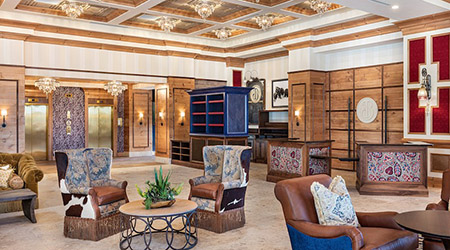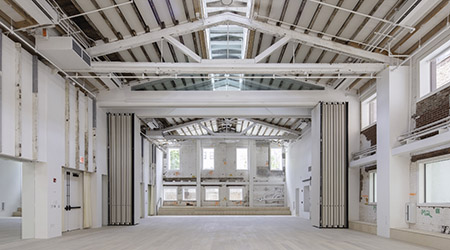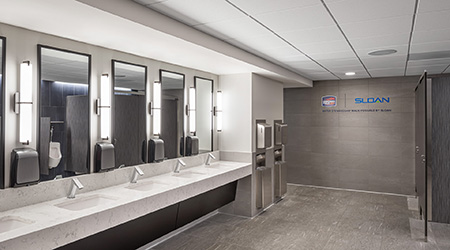
Case Study: Hotel Mixes Modern and Traditional Elements
January 7, 2022
At The Villages a sense of tradition and history is part of the design brief. It is abundantly evident in the recently completed Brownwood Hotel, where a bold mixture of contemporary and traditional elements come together to create the appearance that “they’ve always been there.” This multi-styled aesthetic informs the finishes, the furniture and even the ceilings, where decorative thermoformed panels from Ceilume add the patterning and texture that completes the design gesture.
Located in Brownwood, the 150-room hotel accommodates business and personal travelers and provides medical hospitality for patients and their families coming for treatment at the adjoining outpatient hospital, the Center for Advanced Healthcare at Brownwood. The two buildings, designed and built concurrently, were collaborations between The Villages’ design group led by Tracy Morse (one of the three managing members of the family that founded The Villages) and ESa (Earl Swensson Associates), which provided master planning, architectural and interior design. Both reflect the overall theme of Brownwood, the spirit of the Floridian cowboy. Thematic patterns like the paisley of the cowboy’s bandana appear in various applications such as carpets and upholstery of the lobby furniture. Decorative elements hailing from a broad range of styles fit together, mixing contemporary and traditional for an overall effect of a design that has evolved over time, a kind of instant history.
The public areas of the hotel like the main lobby and lobby bar are decorated and furnished with materials that draw liberally on the cowboy tradition. There is extensive use of wood and dark leather, fabrics that recall Native American weaving and the look of the horse blanket and a hotel logo resembling a cattle brand that is worked into the decor in numerous locations. Juxtaposed with these rustic references are elements of refined European opulence, like rich blue and red velvets, formal millwork, crystal chandeliers and coffered ceilings. Luxury has tamed the frontier, and the expressions of formality pull together the disparate styles.
The coffered ceiling in the Main Lobby is a particularly interesting modern take on a traditional style, since it is actually a suspended ceiling with accessible area above it for mechanical, plumbing and electrical services. It is made of Ceilume thermoformed ceiling panels in a conventional T-bar suspension grid, a coffered panel pattern called Oxford in the color Sand. The grid is set above millwork beams, making a kind of coffer-within-coffer effect that presents the chandeliers to maximum advantage, and gives the room a feeling of solid substantiality. At the same time, it provides all the practical advantages of an accessible ceiling, including high NRC acoustic control via the inclusion of SoniGuard acoustic insulation above each panel.
In the adjacent bar, thermoformed ceilings are used to achieve a different traditional accent, that of the stamped metal ceiling. The Fleur-des-Lis pattern in metallic Tin finish fills in perfectly for the popular early 20th century ceiling material, and gives a traditional counterbalance to the decidedly contemporary lounge furnishings of the room.
In the Pre-Function Hall that leads to the hotel’s banquet rooms, the furniture is formal, but the ceiling strikes a contemporary note using lacelike Victorian panels – a versatile pattern that can appear either traditional or contemporary in different contexts – surrounded by flat Serenity panels. The bright, delicate ceiling pattern, the warm whites of the walls and carpet, and the rich daylighting thanks to generous glazing all combine to give the hall an airiness and sense of spacious grace.
“Even though most everything in The Villages is new,” says ESa, Interior Designer, Jarred Bobo. “The goal is to make everything there appear to have been constructed years ago.”
If the mixture of styles is daring, it achieves the strategic goal of seeming to have been there for decades and evolved organically. Leveraging the ceiling in this strategy proved to be an effective way to add texture and interest, with the wide range of available panel styles providing smart complements to several different, highly eclectic designs.
Next
Read next on FacilitiesNet












